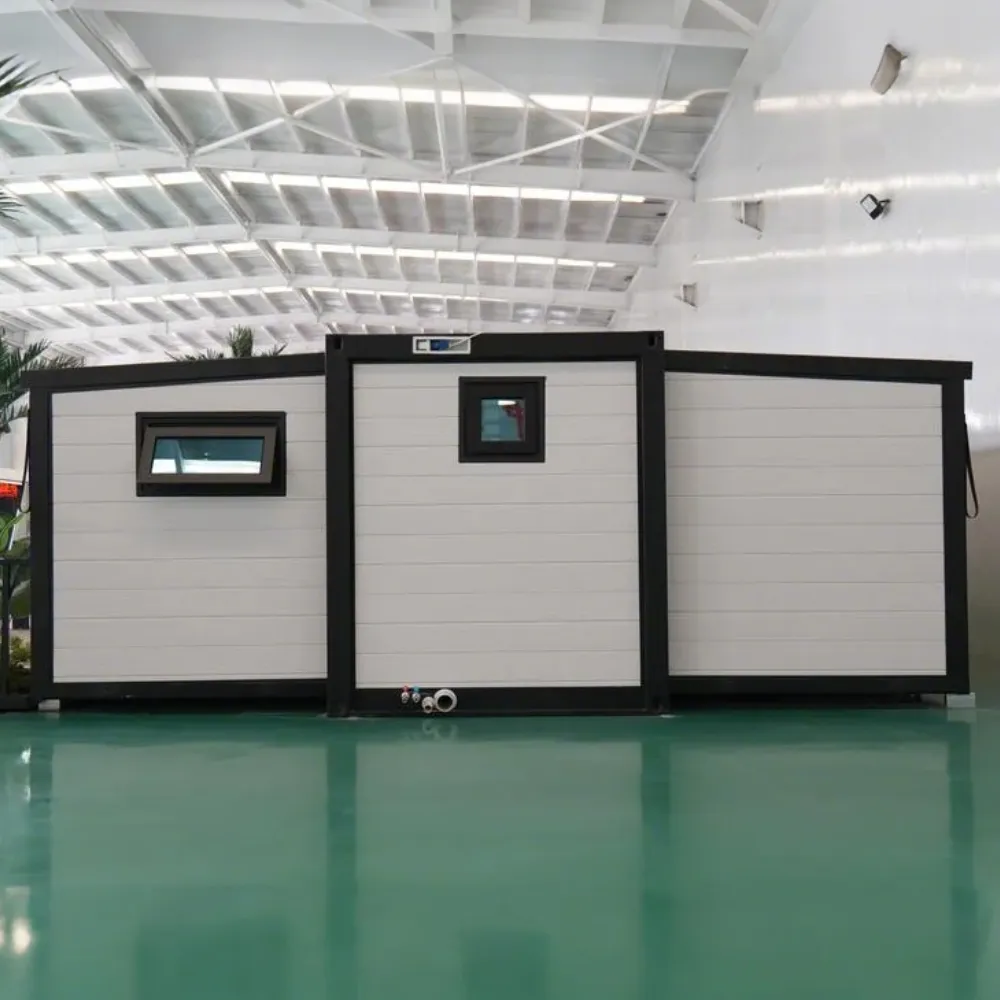ทำความเข้าใจเกี่ยวกับบ้านแบบขยายได้และความต้องการในการบำรุงรักษา
องค์ประกอบโครงสร้างของบ้านแบบขยายได้
บ้านที่สามารถขยายได้ดึงดูดความสนใจมาก เพราะมันสามารถขยายให้ใหญ่ขึ้นได้จริงๆ เมื่อต้องการพื้นที่เพิ่ม อะไรที่ทำให้สิ่งนี้เป็นไปได้? พูดง่ายๆ ก็คือชิ้นส่วนพื้นฐานของการก่อสร้าง เช่น ผนัง หลังคา และฐานราก ที่มีบทบาทร่วมกัน ผู้สร้างส่วนใหญ่เลือกใช้โครงเหล็กและแผงโมดูลาร์ เพราะวัสดุเหล่านี้สามารถรับแรงได้ดี และยังมีความยืดหยุ่นพอที่จะให้การขยายตัวเกิดขึ้นได้ การต่อกันของแต่ละส่วนจัดว่าฉลาดทีเดียว เมื่อมีผู้ต้องการเพิ่มพื้นที่ขนาดใหญ่ขึ้น โครงเหล็กจะทำหน้าที่เสมือนกระดูกสันหลังที่รองรับส่วนที่เป็นโมดูลาร์เหล่านี้ให้เลื่อนออกมาสู่ตำแหน่งที่ต้องการ การจัดวางเช่นนี้ช่วยให้บ้านมีความมั่นคงแม้จะขยายเพิ่มเติมหลายครั้งในระยะเวลายาวนาน
เมื่อพูดถึงการสร้างบ้านเหล่านี้ ไม่มีใครปล่อยให้ทำตามอำเภอใจโดยไม่มีกฎเกณฑ์ มีการกำหนดข้อบังคับไว้อย่างชัดเจนด้วยเหตุผลที่ดี นั่นคือเพื่อให้สิ่งต่าง ๆ มีความปลอดภัยและมั่นคงแข็งแรงในระยะยาว มาตรฐานเช่น International Residential Code และ Uniform Building Code กำหนดไว้อย่างละเอียดว่าสิ่งต่าง ๆ จำเป็นต้องดำเนินการอย่างไรในระหว่างการก่อสร้าง การปฏิบัติตามแนวทางเหล่านี้จะช่วยให้บ้านสามารถต้านทานปัญหาจากสภาพอากาศทุกรูปแบบ หรือแม้แต่แผ่นดินไหวหากจำเป็นต้องเผชิญ ผู้เป็นเจ้าของบ้านย่อมได้รับความอุ่นใจอย่างแท้จริงว่าบ้านของตนจะไม่พังทลายลงมาทันทีเมื่อธรรมชาติเกิดความไม่สงบ
ความท้าทายในการบำรุงรักษาที่เป็นเอกลักษณ์สำหรับการออกแบบที่สามารถขยายได้
การบำรุงรักษา บ้านที่ขยายได้ นำเสนอความท้าทายที่สำคัญหลัก ๆ เนื่องจากลักษณะที่เคลื่อนไหวได้ของบ้าน หนึ่งในปัญหาหลักคือการไม่ตรงแนวที่เกิดขึ้นตามกาลเวลา ซึ่งอาจเกิดขึ้นเมื่อบ้านเคลื่อนย้ายระหว่างสถานะที่ขยายและหดกลับ สิ่งนี้อาจนำไปสู่จุดที่มีแรงดันภายในโครงสร้างที่อาจทำให้บ้านอ่อนแอลง
นอกจากนี้ การออกแบบที่สามารถขยายได้มักต้องเผชิญกับปัญหาเกี่ยวกับการเชื่อมต่อและซีลกันน้ำ พื้นที่ที่ชิ้นส่วนแบบโมดูลาร์เชื่อมต่อกันจะต้องรักษารูปทรงเดิมไว้ เพื่อป้องกันไม่ให้เกิดการรั่วซึมหรือความล้มเหลวในการกันความร้อน เทคนิคเฉพาะ เช่น การปิดผนึกใหม่เป็นประจำและการตรวจสอบการจัดแนว เป็นสิ่งจำเป็นเพื่อรักษาประสิทธิภาพของชิ้นส่วนเหล่านี้
กลยุทธ์บำรุงรักษาเชิงรุกสำหรับบ้านที่สามารถขยายพื้นที่ได้
ระเบียบวิธีการตรวจสอบเป็นประจำสำหรับระบบแบบขยายได้
การรักษาบ้านแบบขยายได้ให้อยู่ในสภาพที่ดีนั้นขึ้นอยู่กับการตรวจสอบเป็นประจำ และการมีรายการตรวจสอบที่ชัดเจนจะช่วยให้มั่นใจได้ว่าไม่มีส่วนใดถูกละเลย ทุกๆ สามเดือนหรือประมาณนั้น ควรตรวจสอบส่วนโครงสร้างหลักๆ เช่น ผนัง หลังคา และฐานราก ซึ่งเป็นสิ่งที่ช่วยยึดทั้งหมดให้อยู่ด้วยกัน สำรวจดูว่ามีรอยร้าว คราบน้ำ หรือจุดที่ดูเหมือนไม่อยู่ในระดับเดิมอีกต่อไปหรือไม่ จากนั้นทุกปี ควรใช้เวลาเพิ่มเติมในการทดสอบชิ้นส่วนที่เกี่ยวข้องกับกลไกการขยายตัว ซึ่งเป็นส่วนที่ทำให้บ้านสามารถขยายหรือหดตัวตามความจำเป็น ลองตรวจสอบให้ดีว่าชิ้นส่วนเหล่านี้ยังเคลื่อนไหวได้อย่างราบรื่นโดยไม่ติดขัด งานบำรุงรักษาเล็กๆ น้อยๆ ที่ทำตอนนี้สามารถช่วยป้องกันปัญหาใหญ่ในอนาคตได้ เมื่อปัญหาการขยายตัวเริ่มก่อให้เกิดความเสียหายที่ชัดเจน
การจัดการกับความเสื่อมของชิ้นส่วนในจุดเชื่อมต่อแบบโมดูลาร์
การเชื่อมต่อแบบโมดูลาร์ที่พบในบ้านที่สามารถขยายได้มักจะแสดงสัญญาณของความสึกหรอตามกาลเวลา เนื่องจากมีการเคลื่อนไหวมากในระหว่างการขยายหรือหดตัว ควรสังเกตจุดที่เสียหายได้ง่าย เช่น ซีลยางรอบประตู และบริเวณที่แต่ละส่วนเชื่อมต่อกัน พื้นที่เหล่านี้จำเป็นต้องได้รับการดูแลเป็นพิเศษ เนื่องจากปัญหาที่เกิดขึ้นในจุดเหล่านี้อาจนำไปสู่ปัญหาใหญ่ในอนาคต การใช้วัสดุคุณภาพสูง หรือสารกันซึมพิเศษที่ผลิตขึ้นเพื่อวัตถุประสงค์นี้โดยเฉพาะ สามารถสร้างความแตกต่างอย่างมากในเรื่องอายุการใช้งานโดยรวมของทุกสิ่ง บางครั้งช่างก่อสร้างยังแนะนำให้ตรวจสอบจุดเหล่านี้อย่างสม่ำเสมอเป็นส่วนหนึ่งของการบำรุงรักษาปกติ เพื่อตรวจพบปัญหาเล็กน้อยก่อนที่จะลุกลามกลายเป็นปัญหาใหญ่ที่ปวดหัวในภายหลัง
ข้อควรพิจารณาเกี่ยวกับสภาพอากาศและภูมิอากาศสำหรับบ้านที่สามารถขยายได้
การป้องกันน้ำและความชื้นก่อนฤดูกาลที่รุนแรง
การกันน้ำและความทนทานต่อสภาพอากาศมีความสำคัญอย่างมากเมื่อเตรียมบ้านแบบขยายได้ให้พร้อมรับฤดูกาลที่ยากลำบากและสภาพอากาศที่แปรปรวน หากร่างโครงสร้างโดยไม่มีการเตรียมการที่เหมาะสม บ้านเหล่านี้จะไม่สามารถทนต่อสภาพธรรมชาติที่รุนแรงได้ สิ่งแรกที่คนส่วนใหญ่มักเริ่มทำคือการอุดรอยรั่วทุกจุดที่พบ ซึ่งหมายถึงการตรวจสอบและอุดช่องว่างรอบๆ หน้าต่าง ประตู ช่องระบายอากาศ และรอยต่อต่างๆ ของตัวบ้านที่อากาศและน้ำมักจะซึมเข้ามา จากนั้นจึงเป็นขั้นตอนของการติดฉนวนกันความร้อนในจุดที่ได้รับผลจากอุณหภูมิเปลี่ยนแปลง เช่น ผนัง พื้น และโดยเฉพาะหลังคา การมีฉนวนที่ดีจะช่วยให้อุณหภูมิภายในบ้านอบอุ่นสบายไม่ว่าสภาพอากาศภายนอกจะเป็นอย่างไรในช่วงฤดูหนาว อย่าลืมเรื่องรางน้ำฝนด้วย เจ้าของบ้านควรตรวจสอบให้แน่ใจว่ารางน้ำและท่อระบายน้ำสะอาดปราศจากเศษซากสิ่งสกปรกอย่างน้อยสองครั้งต่อฤดูกาล เพราะการสะสมของน้ำอาจนำไปสู่ปัญหาที่ไม่มีใครต้องการในอนาคต เมื่อทุกขั้นตอนเหล่านี้ดำเนินการอย่างถูกต้อง บ้านแบบขยายได้จะมีโอกาสใช้งานได้อย่างยาวนานผ่านหลายฤดูหนาวโดยไม่เกิดปัญหาใหญ่
การปรับกลไกการขยายใหเหมาะสมกับการเปลี่ยนแปลงสภาพภูมิอากาศ
เมื่อฤดูกาลเปลี่ยน บ้านแบบขยายได้จำเป็นต้องได้รับการดูแลเป็นพิเศษในเรื่องระบบการขยายตัว เพื่อให้สามารถทำงานได้อย่างราบรื่นตลอดทั้งปี อุณหภูมิที่เปลี่ยนแปลงขึ้นลงและระดับความชื้นที่ผันผวน อาจส่งผลต่อชิ้นส่วนเครื่องจักรต่าง ๆ เช่น บานพับ รางเลื่อน และระบบล็อก ซึ่งมักจะเกิดปัญหาบวมพอง หดตัว หรือมีคราบน้ำควบแน่นรบกวน เมื่ออากาศเปลี่ยนแปลงอย่างรุนแรง ดังนั้นจึงควรตรวจสอบชิ้นส่วนเหล่านี้เป็นระยะ ๆ ผู้ใช้งานส่วนใหญ่พบว่า การตรวจสอบและบำรุงรักษาทุกสองสามเดือน ช่วยแก้ปัญหาได้อย่างมีนัยสำคัญ การหล่อลื่นชิ้นส่วนที่เคลื่อนไหวได้จะช่วยให้ทำงานได้อย่างราบรื่น ขณะเดียวกันการขันสกรูที่หลวมก่อนจะเกิดปัญหาใหญ่ ก็ช่วยป้องกันปัญหาที่อาจเกิดขึ้นในอนาคต การบำรุงรักษาอย่างสม่ำเสมอเพียงเล็กน้อยจึงช่วยยืดอายุการใช้งานและป้องกันการเสียหาย รวมถึงทำให้กำแพงที่ขยายออกได้ทำงานได้อย่างสมบูรณ์แบบเป็นเวลานานหลายปี การดูแลปัญหาตามฤดูกาลเหล่านี้ จะช่วยให้คุณเพลิดเพลินกับการอยู่อาศัยในบ้านแบบขยายตัวได้อย่างไม่มีสะดุด ไม่ว่าจะเป็นเช้าวันหนาวเย็นหรือช่วงบ่ายที่ร้อนระอุในฤดูร้อน

การนำเทคโนโลยีอัจฉริยะมาใช้
ระบบตรวจสอบความสมบูรณ์โครงสร้างด้วยเทคโนโลยีปัญญาประดิษฐ์
การนำระบบตรวจสอบที่ขับเคลื่อนด้วยปัญญาประดิษฐ์มาใช้ในบ้านแบบขยายได้สามารถปฏิวัติวิธีที่เจ้าของบ้านใช้ในการตรวจสอบและบำรุงรักษาความสมบูรณ์ของโครงสร้างบ้าน เทคโนโลยีเหล่านี้จะประเมินสถานะของอาคารแบบเรียลไทม์อย่างต่อเนื่อง พร้อมแจ้งเตือนทันทีหากมีความผิดปกติที่เกี่ยวข้องกับโครงสร้างและวัสดุ
เครื่องมืออัตโนมัติสำหรับการติดตามประสิทธิภาพการขยายตัว
เครื่องมืออัตโนมัติถือเป็นสิ่งที่มีค่ามากในการวัดประสิทธิภาพของกลไกการขยายตัวในบ้านแบบขยายได้ โดยให้ข้อมูลเชิงลึกและคำแนะนำสำคัญแก่เจ้าของบ้าน เครื่องมือเหล่านี้ รวมถึงเซ็นเซอร์ขั้นสูงและแอปพลิเคชัน จะให้ข้อมูลแบบเรียลไทม์โดยละเอียดเกี่ยวกับการทำงานของส่วนต่าง ๆ ที่สามารถขยายตัวได้ของบ้าน ช่วยให้เจ้าของบ้านลดการตรวจสอบด้วยตนเอง
แนวทางการบำรุงรักษาที่ประหยัดต้นทุน
เทคนิคซ่อมแซมด้วยตนเองที่เหมาะกับงบประมาณ
บ้านแบบขยายได้ไม่จำเป็นต้องทำให้กระเป๋าแฟบจากค่าใช้จ่ายในการบำรุงรักษาเสมอไป มีวิธีการมากมายที่สามารถดูแลให้บ้านทำงานได้อย่างราบรื่นโดยไม่ต้องใช้เงินจำนวนมาก ส่วนใหญ่แล้วผู้คนมักพบว่า การแก้ไขปัญหาเล็กๆ น้อยๆ ด้วยตนเองนั้นช่วยได้มากในการจัดการงานบำรุงรักษาปกติ ก่อนที่ปัญหาจะลุกลาม ควรตรวจสอบส่วนประกอบโครงสร้างต่างๆ เช่น แผ่นพื้น คาน และบานพับ เพื่อดูว่ามีรอยร้าว คราบสนิม หรือจุดอ่อนอื่นๆ ที่อาจส่งผลต่อความแข็งแรงของโครงสร้างในระยะยาว นอกจากนี้ อย่าลืมทาสารกันซึมคุณภาพดีบนชิ้นส่วนโลหะเป็นประจำตลอดปี เพราะความชื้นเป็นศัตรูตัวร้าย โดยเฉพาะในช่วงฤดูฝนหรือเดือนที่อากาศชื้น การมีกล่องเครื่องมือที่ใช้งานได้ดีอยู่ใกล้ๆ มือจะช่วยลดปัญหาในอนาคตได้ เพียงแค่ขันสกรูที่หลวมให้แน่น ตรวจพื้นที่สีที่ซีดจางเพื่อแต้มสีใหม่ หรือขูดคราบสนิมบนพื้นผิวขณะยังแก้ไขได้ไม่ยาก ความพยายามเล็กๆ เหล่านี้จะช่วยให้บ้านยังคงความแข็งแรงและใช้งานได้ดีไปอีกหลายปี
การประหยัดในระยะยาวด้วยการบำรุงรักษาเชิงป้องกัน
การลงทุนเงินไปกับการดูแลเชิงป้องกันนั้น แท้จริงแล้วช่วยประหยัดค่าใช้จ่ายในการซ่อมแซมบ้านในระยะยาวได้มากทีเดียว เมื่อผู้คนทำการตรวจเช็กสภาพโดยรวมของบ้านอย่างสม่ำเสมอ ก็จะสามารถค้นพบปัญหาเล็กๆ ได้ตั้งแต่แรก ก่อนที่มันจะกลายเป็นปัญหาใหญ่ที่ต้องเสียเงินจำนวนมากในการแก้ไข การดูแลแบบเชิงรุกนี้ จะช่วยให้สิ่งต่างๆ เช่น หลังคา ผนัง และชิ้นส่วนเครื่องกลต่างๆ ยังคงทำงานได้อย่างเต็มประสิทธิภาพเป็นเวลานานกว่าที่ควรจะเป็น อย่าลืมถึงเรื่องฉนวนกันความร้อนและความเย็นด้วย การทำให้บ้านมีฉนวนหุ้มห่อที่ดี จะช่วยลดปริมาณพลังงานที่ใช้ในการทำความร้อนหรือทำให้เย็นพื้นที่ต่างๆ ซึ่งช่วยให้ค่าใช้จ่ายรายเดือนลดลงอย่างต่อเนื่องตลอดหลายเดือนที่ผ่านไป การอุดรอยรั่วเล็กๆ น้อยๆ การบำรุงรักษาเครื่องใช้เก่าๆ หรือแม้กระทั่งการเพิ่มฉนวนที่จุดที่เราไม่เคยคิดว่าจะต้องมี ทั้งหมดเหล่านี้ล้วนแต่เป็นการลงทุนที่ช่วยประหยัดเงินในกระเป๋า ช่วยให้สภาพแวดล้อมภายในบ้านน่าอยู่ขึ้น และทำให้เรารู้สึกดีขึ้นด้วย ที่รู้ว่าบ้านยังคงอยู่ในสภาพดี ไม่ได้พังทลายลงจากปัญหาที่เกิดขึ้นลับหลังประตู
คำถามที่พบบ่อย: สิ่งจำเป็นในการบำรุงรักษาบ้านแบบขยายได้
ข้อต่อแบบขยายได้ควรตรวจสอบบ่อยแค่ไหน?
การตรวจสอบข้อต่อแบบขยายได้อย่างสม่ำเสมอถือเป็นสิ่งสำคัญ โดยทั่วไปควรทำการตรวจสอบทุกหกเดือน การตรวจสอบบ่อยครั้งกว่านี้อาจจำเป็นในบางกรณีขึ้นอยู่กับสภาพแวดล้อมและอัตราการใช้งาน การตรวจสอบอย่างสม่ำเสมอช่วยป้องกันจุดอ่อนทางโครงสร้าง
บ้านแบบขยายได้มีความทนทานต่อสภาพอากาศที่เลวร้ายในระยะยาวได้หรือไม่?
บ้านแบบขยายได้ถูกออกแบบมาให้มีความแข็งแรงทนทานต่อสภาพอากาศที่รุนแรง องค์ประกอบการออกแบบ เช่น บานพับที่เสริมความแข็งแรงเพิ่มเติม จะช่วยเพิ่มความสามารถในการต้านทานสภาพอากาศ และบ้านประเภทนี้ได้พิสูจน์แล้วว่ามีความน่าเชื่อถือเมื่อใช้งานเป็นเวลานาน
สารบัญ
- ทำความเข้าใจเกี่ยวกับบ้านแบบขยายได้และความต้องการในการบำรุงรักษา
- กลยุทธ์บำรุงรักษาเชิงรุกสำหรับบ้านที่สามารถขยายพื้นที่ได้
- ข้อควรพิจารณาเกี่ยวกับสภาพอากาศและภูมิอากาศสำหรับบ้านที่สามารถขยายได้
- การนำเทคโนโลยีอัจฉริยะมาใช้
- แนวทางการบำรุงรักษาที่ประหยัดต้นทุน
- คำถามที่พบบ่อย: สิ่งจำเป็นในการบำรุงรักษาบ้านแบบขยายได้

